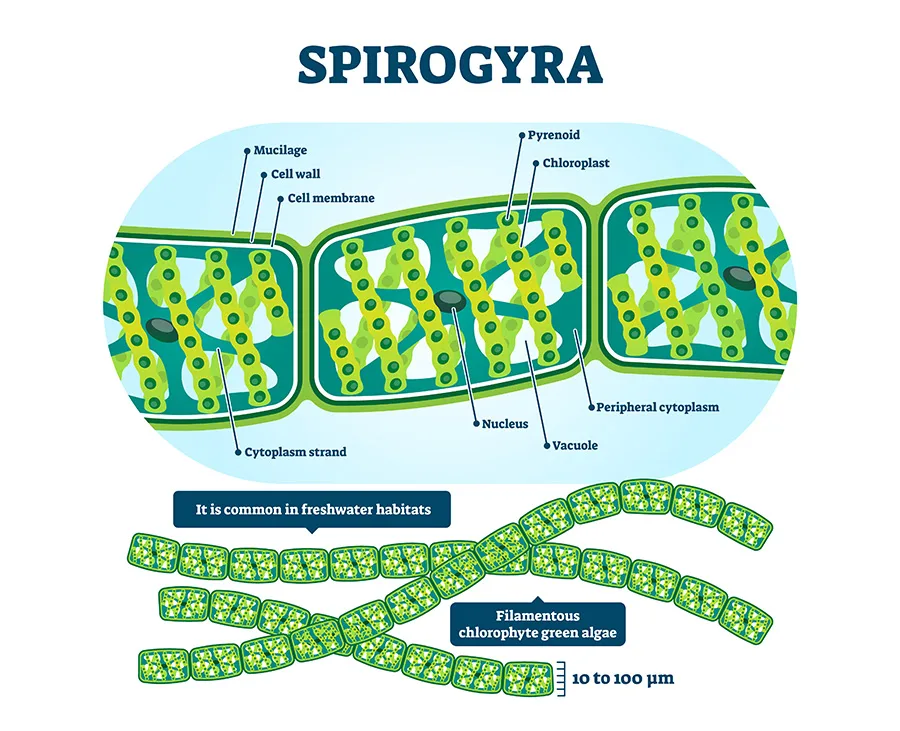
Spirogyra: One of the most common types of floating freshwater algae is Spirogyra algae. It can be found on the surfaces of ponds, lakes, pools, and other still bodies of water. Spirogyra is derived from two Greek words: Speria (coil) and gyras (twisted).
Spirogyra (genus Spirogyra) is a genus of over 400 species of free-floating green algae (division Chlorophyta) found in freshwater habitats around the world. These algae form filamentous structures composed of thin, unbranched chains of cylindrical cells. Their chloroplasts have a distinctive spiral shape. Understanding the classification of Spirogyra is necessary along with its characteristics. The article below explains what spirogyra is, diagrams it, and how it is classified for the NEET exam .
What is Spirogyra?
Spirogyra, commonly known as "water silk" or "pond silk," are free-floating green algae found in freshwater habitats like ponds and lakes. They have a filamentous and unbranched structure, and there are approximately 400 species of Spirogyra. The genus Spirogyra is named after the unique spiral chloroplast present in their cells.
These algae are photosynthetic and contribute significantly to carbon dioxide fixation and oxygen production in their habitats. They are a vital food source for many aquatic organisms. Each Spirogyra cell contains a large central vacuole, where the nucleus is suspended by cytoplasmic strands. The chloroplasts form a spiral around the vacuole and contain pyrenoids for starch storage. The cell wall is composed of cellulose and pectin, giving Spirogyra its slippery texture.
Flower – A Fascinating Organ of Angiosperms
Spirogyra Diagram
A Spirogyra Diagram is provided as follows:

Sexual Reproduction in Flowering Plants MCQ for NEET
Spirogyra Classification
Spirogyra is placed in the Chlorophyta group because it has chlorophyll. There are about 400 different species in this genus.
| Spirogyra Classification | |
| Domain | Eukaryota |
| Spirogyra Kingdom | Plantae |
| Spirogyra Phylum | Chlorophyta |
| Spirogyra Class | Zygnematophyceae |
| Spirogyra Order | Zygnematales |
| Spirogyra Family | Zygnemataceae |
| Spirogyra Genus | Spirogyra |
Pre Fertilisation: Structures and Events
Spirogyra Structure
The structure of Spirogyra can be described as follows:
- Vegetative Structure: Spirogyra has an unbranched filamentous thallus.
- Cellular Composition: The thallus is multicellular, with cylindrical cells joined end to end.
- Size: The cells are 10-100 µm in width and can grow several centimetres long.
- Appearance: The filaments appear slim due to a mucilage sheath around them.
- Cell Wall: The cell wall is composed of two layers: inner cellulose and outer pectose. The sliminess of the mucilage sheath is due to pectose dissolution in water.
- Cell Contents: Each cell contains a nucleus, cytoplasm, a large central vacuole, and spiral chloroplasts.
- Chloroplast Structure: Chloroplasts are ribbon-shaped and arranged spirally. A cell may have 1-16 chloroplasts.
- Pyrenoids: Chloroplasts contain many pyrenoids in a row, which store starch and protein.
Spirogyra Chloroplast
Spirogyra is a long, thin green algae with unique chloroplasts.The name "spirogyra chloroplasts" comes from the Greek words "speira," meaning "coil," and "gyros," meaning "circle," because they resemble coiled circles.
Spirogyra chloroplasts are large flat structures that wrap around the cell's central vacuole. This spiral shape is a distinctive feature of Spirogyra and helps it capture more sunlight for photosynthesis.
Inside the chloroplasts are pyrenoids, which are protein-starch complexes that store starch. Through photosynthesis, Spirogyra produces oxygen, which is important for maintaining oxygen levels in the freshwater environments where it lives.
Spirogyra Characteristics
Spirogyra is a type of green algae that forms long, unbranched chains of cylindrical cells in freshwater environments worldwide. It is commonly known as "water silk" or "pond silk" due to its shiny appearance and hair-like strands. Here are some key points about Spirogyra:
Physical Characteristics
- Multicellular Structure: Spirogyra consists of multicellular filaments, with each filament ranging from 10 to 100 micrometers in width and several centimeters in length.
- Cell Wall: Each cell is surrounded by a cell wall made up of cellulose and pectose, giving Spirogyra its slimy texture.
- Mucilaginous Sheath: The filaments are covered in a slippery mucilaginous sheath, helping them float and move in water.
Internal Structure
- Chloroplasts: Spirogyra's chloroplasts are large and ribbon-shaped, containing chlorophyll for photosynthesis and pyrenoids for carbohydrate storage.
- Central Vacuole: Each cell has a large central vacuole that stores water and maintains cell pressure.
- Nucleus: The nucleus controls cellular activities and houses genetic material.
- Cytoplasm: Cytoplasm fills the space between the cell wall and the central vacuole, containing essential organelles.
Habitat and Importance
- Spirogyra is found in freshwater habitats like ponds, lakes, and slow streams, where it plays a crucial role in the ecosystem by:
- Producing oxygen through photosynthesis.
- Serving as a food source for organisms like zooplankton and small fish.
- Indicating water quality, as it thrives in nutrient-rich waters.
| Other NEET Biology Topics | ||
|---|---|---|
| Ribosomes | Pollination | Apomixis |
| Centrosome | Embryo | Tissues |
Spirogyra Locomotion
Spirogyra is a type of algae that can be found in freshwater environments. When spirogyra filaments gather near the water's surface, they form dense sheets or mats. These filaments align closely and in parallel, but they do not physically attach to one another. Since spirogyra relies on sunlight to carry out photosynthesis and produce its own food, these mats must be able to access light effectively.
As a result, the filaments exhibit a slow, coordinated movement where they bend, twist, and straighten. This movement helps to increase the surface area of the filaments, allowing them to capture more light. Additionally, the repetitive movements create friction between the filaments within the mat, aiding in the overall locomotion of spirogyra mats.
Spirogyra Reproduction
Spirogyra undergoes three types of reproduction: vegetative, asexual, and sexual. Its life cycle is haplontic, meaning the dominant stage is a free-living haploid (n) gametophyte, and the sporophyte is represented only by the diploid zygote (2n).
Vegetative Reproduction
Vegetative reproduction in Spirogyra occurs through fragmentation, which is its preferred mode under favourable conditions. The vegetative filament, after fragmentation, develops into a new filament. Each fragment undergoes multiple divisions and elongations to form a new filament. Fragmentation can occur due to mechanical injury or changes in salinity and temperature.
Asexual Reproduction
Asexual reproduction in Spirogyra is found in few species and is achieved through the formation of azygospores, akinetes, or aplanospores. Aplanospores form under unfavourable conditions when the protoplast shrinks and forms a wall around it. Akinetes are similar, but they have a thicker cell wall. These spores are non-motile and develop into new filaments after the decay of the parent filament.
Sexual Reproduction
Sexual reproduction in Spirogyra is isogamous, with male and female gametes of similar size. This process occurs through conjugation, which can be scalariform or lateral.
Scalariform Conjugation
In scalariform conjugation, two filaments come together and lie side by side, forming a ladder-like structure. A tube-like structure develops from each cell, and a conjugation canal is formed between two cells after fusion. The zygotes are released after the decay of the parent filament and germinate under favourable conditions.
Sexual Reproduction in Flowering Plants
Lateral Conjugation
Lateral conjugation involves adjacent cells functioning as male and female gametes, with conjugation tubes formed between cells of the same filament. There are two types: direct lateral conjugation and indirect lateral conjugation.
Direct Lateral Conjugation:
- Passage formed between two adjacent cells.
- Male gametes fuse with female gametes.
- Zygotes formed in alternate cells.
Indirect Lateral Conjugation:
- Conjugation canal is formed by the cell with the male gamete.
- Joins the adjacent cell with the female gamete.
Zygospores
The zygote in Spirogyra is known as a zygospore, which remains dormant until favourable conditions are available. During germination, the zygospore undergoes meiosis to form four haploid nuclei, of which only one survives and develops into a new haploid filament.
Aplanogametes
The entire protoplast of Spirogyra acts as a gamete, known as aplanogametes, which are formed in the gametangia at the end of the growing season.
Overall, Spirogyra's life cycle is haplontic, with the dominant stage being a free-living haploid gametophyte and the sporophyte represented only by the diploid zygote.
Spirogyra Is Unicellular Or Multicellular
The cellular makeup of spirogyra is unique. They can exist as single cells or as multicellular filaments, making them both unicellular and multicellular organisms. Individual spirogyra cells join end-to-end when forming filaments, creating strands up to several centimeters long. Each cell in the filament is oblong, measuring 10-100 micrometers in length, and except for the first and last cells, each is attached to two other cells—one at each end. Some species have a holdfast cell at the end of the filament, which is distinguishable by its location and less green color.
Spirogyra cells contain chloroplasts, giving them their green color. These chloroplasts are spiral-shaped. The cell wall of each spirogyra cell consists of two layers: an inner layer made of cellulose and an outer layer made of pectin. These layers, along with an outer coating of mucilage, hold the unicellular segments together to form multicellular filaments. Inside each cell is a nucleus, a large vacuole, chloroplasts, and pyrenoids (proteins that store starch). All cells in the filament can divide except for the holdfast cell.
Physics Wallah is the Online platform for NEET exam . It offers various courses, including free coaching, classes for classes 11 and 12, a repeaters' course, and more, in multiple languages. PW is known for reasonable fees, experienced faculty, and various resources like live classes, doubt-clearing sessions, and study materials.
| NEET Exam Important Links | |
|---|---|
| NEET Syllabus | NEET Biology Diagrams |
| NEET Biology MCQ | NEET Biology Chapter wise Weightage |
| NEET Biology Notes | NEET Previous Year Question papers |
Spirogyra FAQs
Why is Spirogyra called algae?
What are Spirogyra Characteristics?
What is the botanical name of Spirogyra?
What phylum is Spirogyra?
Is Spirogyra a protozoa?
Is Spirogyra male or female?










